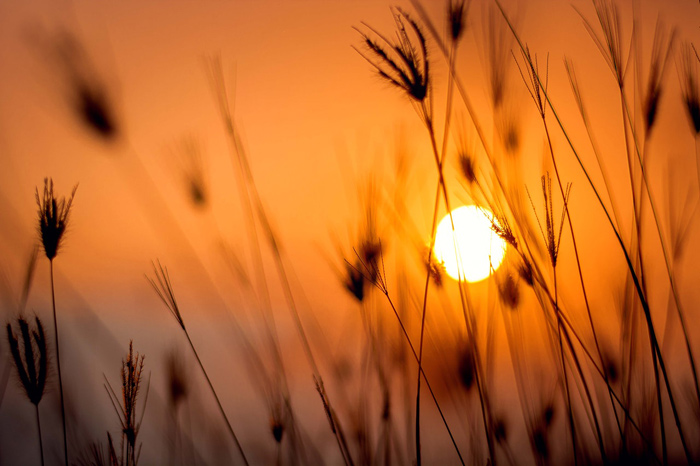“天时人事日相催,冬至阳生春又来。”大伙都了解,冬至是北半球全年中白天最短、黑夜最长的一天,但你可能不知道的是,冬至却不是日出最晚、日落最早的一天。本文就带你知道几个关于冬至的趣味小常识。
 [Photo/Pexels]
[Photo/Pexels]
1. THE WORD SOLSTICE TRANSLATES TO SUN STAND STILL.
冬至英文solstice的意思是“太阳静止不动”
Solstice derives from the Latin term solstitium, containing sol, which means sun, and the past participle stem of sistere, meaning to make stand. this comes from the fact that the sun’s position in the sky relative to the horizon at noon, which increases and decreases throughout the year, appears to pause in the days surrounding the solstice.
冬至英文solstice来自于拉丁文solstitium,sol意思是“太阳”,stitium是sistere的过去分词形式,意思是“停下来”。这是基于对正午时分太阳在天空中地方的察看,太阳的地方会伴随四季轮回升降,而在冬至前后太阳好像停下来不动了。
2. ANCIENT CULTURES VIEWED THE WINTER SOLSTICE AS A TIME OF DEATH AND REBIRTH.
古时候文化将冬至视为死亡和重生的时节
The seeming death of the light and very real threat of starvation over the winter months would have weighed heavily on early societies, who held varied solstice celebrations and rites meant to herald the return of the sun and hope for new life. Cattle and other animals were slaughtered around midwinter, followed by feasting on what was the last fresh meat for several months.
冬月里黑夜漫漫,太阳好像远去了。在饥饿的威胁下,古人会举行各种冬至庆祝活动和仪式来迎接太阳的回归,期待新生的到来。冬至时节古人会宰杀牲口和其他动物,然后在下面几个月尽情享用最后的鲜肉。
3. EARTH IS CLOSEST TO THE SUN AROUND THE WINTER SOLSTICE.
冬至前后地球距离太阳近期
Though it doesn’t feel like it in the Northern Hemisphere, Earth is closer to the sun in early January— approximately 3 million miles closer—than it is in early July. The shortest distance between the sun and a planet is called perihelion; in 2021, Earth was at perihelion on January 2.
尽管身在北半球的你可能感觉不到,但地球在1月初比7月初距离太阳更近,近了大约300万英里。太阳和一颗行星最短的距离叫作日前点,2021年地球于1月2日到达日前点。
Despite the proximity to the sun, the reason for cold temperatures is because the Northern Hemisphere receives less sunlight and has cooler temperatures in winter due to Earth’s 23.5-degree tilt. The Northern Hemisphere is tilted away from the sun in winter, and toward it in July.
尽管距离太阳更近,但温度却非常低,这是因为地球倾斜23.5度致使北半球在冬季接收到的阳光更少,因此天气也更冷。北半球在冬季是背离太阳的方向倾斜着身子公转,而在夏季(7月)是向着太阳倾斜。
4. THE WINTER SOLSTICE MARKS THE SHORTEST DAY OF THE YEAR, BUT NOT THE EARLIEST SUNSET.
冬至是一年中白昼最短的一天,但不是日落最早的一天
Though the winter solstice is the day with the least amount of sunlight, that’s not because of the sunset. In fact, the earliest sunset happens about two weeks prior—in 2021 in New York, for example, the winter solstice is December 21, but the earliest sunsets occur on December 7 and 8 .
尽管冬至是日照最少的一天,但这不是由于日落时间早。事实上,日落最早的时间是在约两周以前。以纽约为例,今年的冬至是12月21日,但当地日落最早的日子是12月7日和8日(下午4点28分)。
The discrepancy is due to the way we calculate time. Our clocks operate on an exact 24-hour schedule, but our days are technically a little longer or shorter. One day equals the time between when the sun is at its highest point in the sky, called solar noon, and the next.
这种差异是因为大家计算时间的方法产生的。大家的时钟根据精确的24小时来运行,但从严格意义上来讲大家每一天的时间会长一点或短一点。从太阳升至天空最高点(正午时分)到第二天第三升至最高点的这期间算作一天。
A solar day is slightly longer than 24 hours during the summer and winter solstices and slightly shorter during the spring and fall equinoxes because of Earth’s tilt and orbit. During the winter solstice in New York on December 21, solar noon is actually 11:54 am EST.
因为地球的倾斜角度和公转,夏至和冬至时的一个太阳日比24小时略长,在春分和秋分比24小时略短。纽约冬至日12月21日的正午时分事实上是美国东部标按时间上午11点54分。
英文来源:Mental Floss
翻译编辑:丹妮



